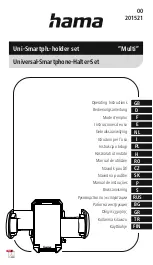
EyeLink II User Manual version 2.12
(07/02/2006)
©
2002-2006 SR Research Ltd.
65
4.4.2.3 GAZE
Gaze position data reports the actual (x, y) coordinates of the subject's gaze on
the display, compensating for head position changes and distance from the
display. The units are in actual display coordinates (usually pixels) which can
be set in the EyeLink II configuration file PHYSICAL.INI. These are the most
useful coordinates for most applications, but may not reflect true eye-rotation
velocities due to head movements. The default EyeLink II coordinates are those
of a 640 by 480 VGA display, with (0, 0) at the top left.
The resolution data for gaze position data changes constantly depending on
subject head position and point of gaze, and therefore is reported as a separate
data type (see below). A typical resolution is 22 pixels per degree for the
suggested EyeLink II setup, with the distance between the subject's eyes and
the display being twice the display's width, and with the standard 640 by 480
screen resolution.
The high resolution of the EyeLink II data is preserved by multiplying the
position by a prescaler, recording the value as an integer in the EDF file, then
dividing by the prescaler when the file is read. The usual prescaler value is 10,
allowing gaze position to be recorded with 0.1 pixel of resolution or a resolution
of 0.0045 degree. Actual EyeLink II resolution is limited only by measurement
noise, which is less than 2 units RMS (0.01 degree, or 40 seconds of arc) in
pupil only mode and approximately 4 units RMS (0.022 degree, or 88 seconds of
arc) in pupil-corneal reflection mode.
4.4.2.4 Gaze Resolution Data
For gaze position, unlike the HREF data, the relationship between visual angle
and gaze position is not constant. The EyeLink II tracker computes and can
record the instantaneous angular resolution at the current point of gaze. This
is measured as the units (usually pixels) per degree of visual angle, computed
for a change in x and y position separately.
This resolution data may be used to estimate distances between gaze positions,
and to compute velocities of eye movements. To compute the angular distance
of two points, compute the x and y angular distances of the points separately by
dividing the distance in pixels by the average of the resolutions at the two
points, then compute the Euclidean distance from the x and y distances. For
instantaneous velocity in degrees per second, compute the x and y velocities,
then divide each by the x or y resolution, square and add the x and y velocities,
and take the square root.
As noted above, typical resolution is 22 pixels per degree. Resolution is
computed at the point of gaze on the display, and can vary up to 15% over the
display. The resolution data in an EDF file is recorded using a prescaler for
extra precision, and noted in the gaze-position section).
















































